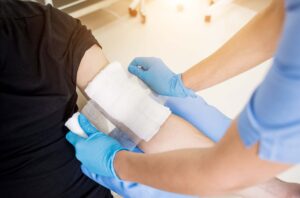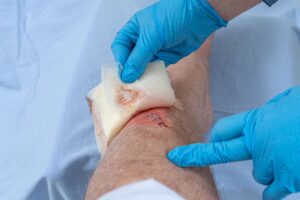Wound healing is a complex biological process that the body undergoes in response to tissue injury. Traditionally, wound management involved keeping the wound dry and exposed to air. However, in recent years, the concept of moist wound healing has gained significant attention among wound care specialists and healthcare professionals. Moist wound healing involves maintaining a controlled moist environment over the wound site, which in many cases, has been found to offer numerous advantages over the traditional dry approach.
In this article, we will explore the efficacy and benefits of moist wound healing as it compares to dry healing as well as its role in the healing process.
Understanding Moist Wound Healing: The Stages
 Moist wound healing consists of several stages, each of which contributes to a faster and more effective healing process.
Moist wound healing consists of several stages, each of which contributes to a faster and more effective healing process.
- Inflammatory Stage: In this initial stage, the body’s immune response is activated to remove any foreign materials and damaged tissues from the wound site. A moist environment during this stage helps prevent the wound from drying out, reducing pain and minimizing the risk of infection.
- Proliferative Stage: During this stage, new tissue is formed to replace the damaged tissue. A moist wound environment supports the migration of specialized cells, such as fibroblasts and keratinocytes, which are crucial for tissue regeneration and wound closure.
- Maturation Stage: In the final stage, the newly formed tissue undergoes remodeling and gains strength over time. A controlled moist environment in this stage supports collagen organization and minimizes scar tissue formation.
Moist vs. Dry Wound Healing: A Comparative Analysis
As referenced above, the traditional dry wound healing method involved exposing the wound to air, keeping it uncovered, and allowing it to scab over. However, research has shown that in many cases, moist wound healing offers significant advantages over this approach.
- Faster Healing: Moist wound healing has been associated with accelerated healing rates compared to the dry method. The presence of moisture enhances cellular activities and promotes the migration of essential cells to the wound site, expediting the healing process.
According to a paper published in ‘Advances in Wound Care’, “A moist environment has been proven to facilitate the healing process of the wound by preventing dehydration and enhancing angiogenesis and collagen synthesis together with increased breakdown of dead tissue and fibrin.”
- Reduced Scarring: Maintaining a moist environment over the wound helps minimize scarring. The controlled moisture levels contribute to organized collagen formation, leading to a more cosmetically appealing outcome.
Another paper on moist wound healing published in 2021 concluded “Many studies have demonstrated that healing in a moist environment results in less inflammation than in a dry environment and thus also improves the quality of healing (less scarring).”
- Lower Risk of Infection: A moist environment prevents the wound from drying out, which can create a barrier against infection-causing pathogens. Additionally, wound dressings used in moist wound healing often contain antimicrobial properties, further reducing the risk of infections.
How to Keep a Wound Moist
 Maintaining a moist wound environment requires proper wound care and the use of appropriate wound dressings. Below are a few guidelines and tips to help keep a wound moist. That said, it’s always best to consult a wound care specialist who can recommend the appropriate dressing for your circumstances and offer recommendations for proper wound care.
Maintaining a moist wound environment requires proper wound care and the use of appropriate wound dressings. Below are a few guidelines and tips to help keep a wound moist. That said, it’s always best to consult a wound care specialist who can recommend the appropriate dressing for your circumstances and offer recommendations for proper wound care.
- Choose the Right Dressing: Select wound dressings that are specifically designed for moist wound healing. These dressings are usually made of materials that can retain moisture while allowing excess fluid to escape, preventing maceration.
- Cleanse the Wound: Before applying the dressing, cleanse the wound with a mild, non-irritating wound cleanser or saline solution. Avoid using harsh antiseptics as they can disrupt the wound healing process.
- Apply the Dressing Correctly: Ensure that the wound is covered entirely by the dressing and that the edges are well sealed to prevent leakage.
- Change the Dressing Regularly: Moist wound dressings need to be changed regularly, as recommended by a wound care specialist. During each dressing change, assess the wound for signs of infection or delayed healing.
Moist Wound Dressings
Moist wound dressings come in various forms, each catering to specific wound types and stages of healing. Some common examples of the different types of moist wound dressings include:
- Hydrogels: Hydrogel dressings consist of a high water content and are ideal for maintaining a moist wound environment.
- Foam Dressings: Foam dressings have excellent absorbent properties and can manage wounds with higher exudate levels while maintaining a moist environment.
- Alginate Dressings: Alginate dressings, derived from seaweed, are highly absorbent and are often used for wounds with heavy exudate. As they absorb fluid, they form a gel-like consistency that keeps the wound moist.
- Hydrocolloid Dressings: Hydrocolloid dressings are designed to form a gel-like layer when they come into contact with wound exudate.
Summing Up the Benefits of Moist Wound Healing
To sum up, below are some of the major benefits of maintaining a moist environment as wounds heal and how it aids in the recovery process.
- Faster Healing: accelerates the wound closure process, leading to quicker recovery times.
- Reduced Scarring: minimizes scar tissue formation.
- Lower Risk of Infection: creates a barrier against pathogens, reducing the risk of infections.
- Enhanced Tissue Regeneration: supports the migration of specialized cells, promoting effective tissue regeneration.
- Improved Angiogenesis: contributes to increased blood vessel formation, aiding in the healing process.
- Optimal Collagen Organization: supports organized collagen formation, ensuring better wound healing.
- Autolytic Debridement: facilitates autolytic debridement, a natural process where the body’s enzymes break down necrotic tissue, promoting cleaner wounds and faster healing.
- Superior Wound Dressings: provides a superior environment for healing and comes in various forms to suit different wound types.
- Reduced Pain: prevents the wound from drying out, minimizing discomfort.
- Better Overall Patient Outcomes: by promoting faster healing and minimizing complications, moist wound healing contributes to improved patient outcomes.
When Moist Wound Healing Might Not Be Recommended
While moist wound healing has numerous benefits and is generally considered the preferred approach for most wounds, there are specific scenarios where it may not be recommended. For example, for wounds with heavy exudate or excessive moisture, maintaining a moist environment may exacerbate the problem. Additionally, wounds that require regular visualization or assessment, such as deep surgical wounds or wounds with suspected foreign bodies, may benefit from a dry wound environment to enable better monitoring. In these types of cases, your wound care specialist may opt for an alternative wound management approach based on a wound assessment and your unique case.
If you or someone you know has suffered a wound or have questions about the healing process, the specialized team at West Coast Wound Center is here to help. Book an appointment at our center today and let us help put you on the path to healing and improve your quality of life.
